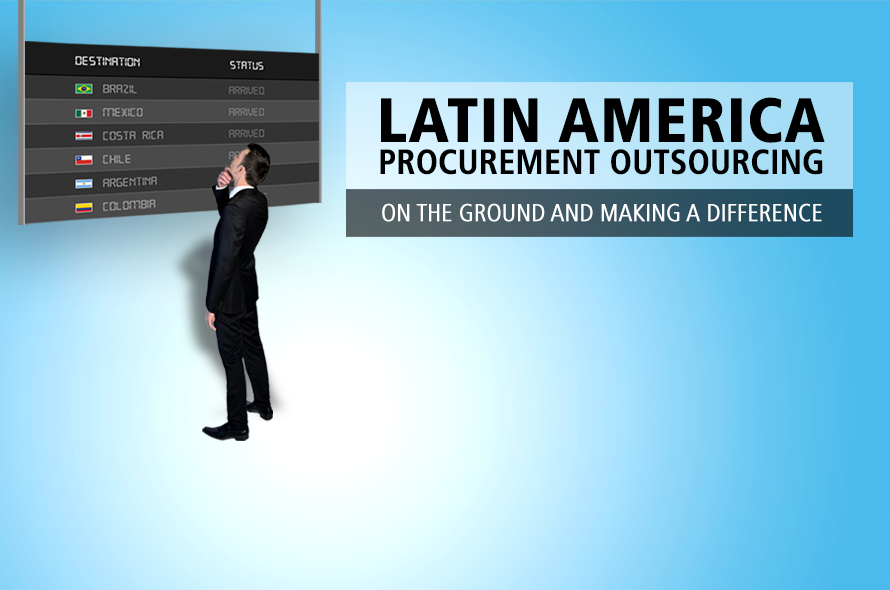Introduction
The outsourcing market in Latin America is pegged to grow at double-digit rates until 2019, with procurement outsourcing accounting for more than 30 percent of this growth.
Latin America offers several advantages beyond cost arbitrage, especially for companies based in the U.S. and Canada, or even European companies looking to outsource or nearshore their procurement operations.
Latin American countries, such as Costa Rica, Brazil, Argentina, Mexico and Chile, for example, offer attractive features for outsourcing and have attracted many leading global companies to invest in call centers, offshore delivery centers, BPOs and shared service centers (SSC).
In this white paper, GEP explores key drivers behind the growth of procurement outsourcing in Latin America and discusses the strategic advantages and benefits of outsourcing procurement to the region. We also share the key considerations when choosing a procurement outsourcing service provider in the region.
The Global Outsourcing Landscape
Markets are more competitive than ever before, margins are lower and the C-suite has significantly higher performance expectations from the enterprise. This is the current state of most businesses worldwide. Hence, enterprises are trying to make every cent count and making extra efforts to achieve extremely aggressive performance and efficiency goals.
Traditionally, large multinational companies have focused their efforts primarily on their core business functions to be more competitive. However, the lack of a focused strategy on optimizing non-core functional areas, such as HR, IT and procurement impacts the overall business performance in the form of higher oeprational costs, lower efficiency, and failure to achieve the desired savings results.
To increase their market competitiveness, many large organizations are increasingly opting for business process outsourcing (BPO) – an efficient and effective approach to drive value from non-core processes by outsourcing them to specialised service providers. BPO services began with IT, HR, and customer service, but as the market gained maturity, a few other highly skilled areas, such as procurement joined the list of commonly outsourced processes, as shown in Figure 1 and Figure 2.
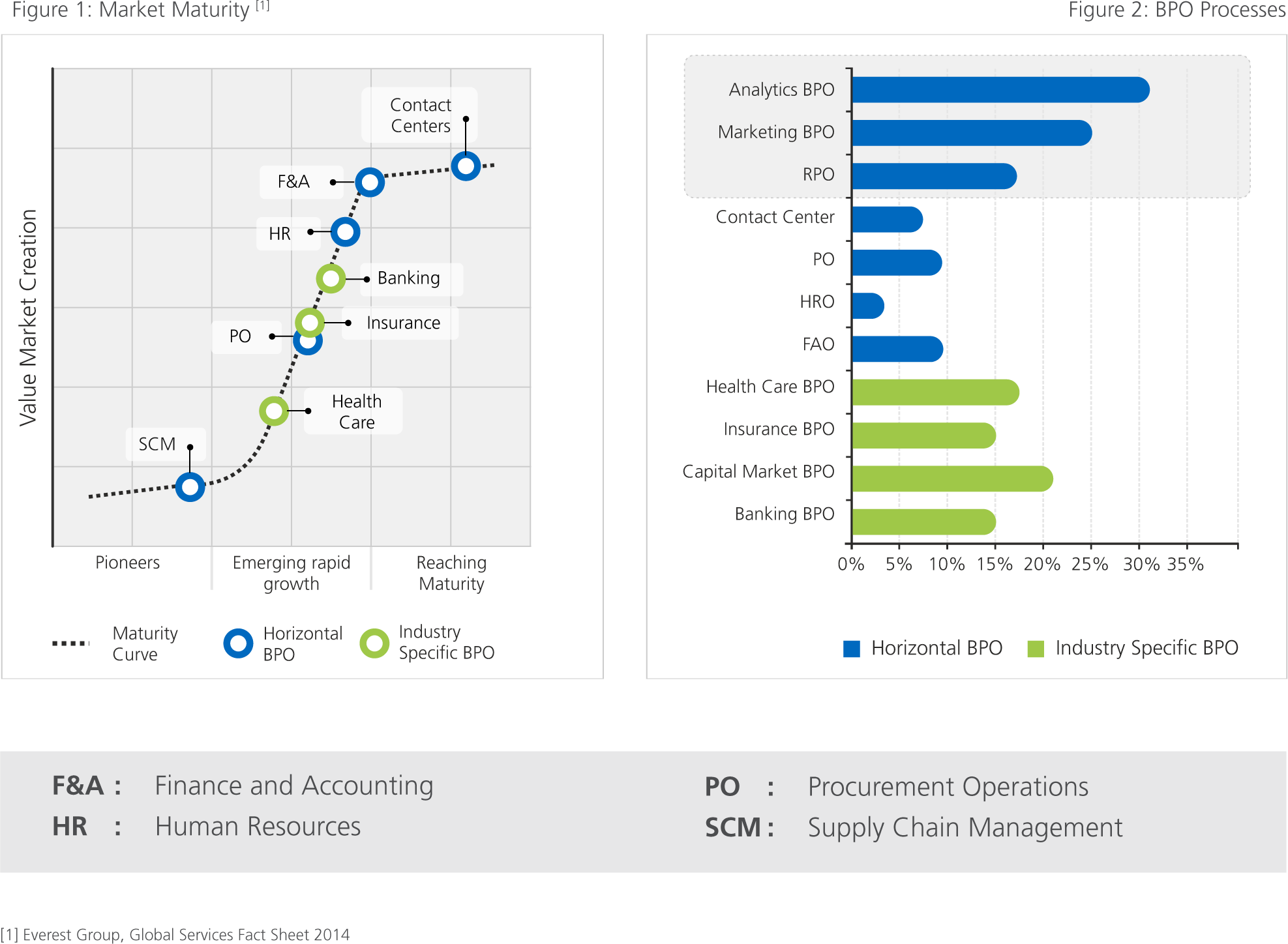
The Business Case for Procurement Outsourcing
Enterprises need to continuously refine their missions and business models, and develop capabilities to quickly adapt to any change in market conditions. To achieve this, they seek cheaper, better, and faster solutions to all their non-core functions or support processes. A recent study from Aberdeen Group noted that a significant number of large global enterprises seek third-party experts to drive down costs for procurement processes. It also notes that more than 260 large global companies from Europe and the United States plan to outsource at least a part of their procurement functions in the coming years.
Table 1 below highlights the key benefits that enterprises can realize by outsourcing their procurement processes.
| Procurement Benefits | Business Improvements |
|---|---|
|
|
|
|
|
|
|
|
|
Table 1 – Benefits of outsourcing procurement functions and impacts on business
Studies conducted by Procurement Leaders Magazine and HfS Research, indicate that big companies like Avaya, Procter & Gamble, Unilever and L’Oréal, among others, have realized the following benefits by outsourcing their procurement processes:
- Double-digit procurement savings percentage
- Enhanced procurement processes with category expertise and sourcing tools
- Partnership and innovation with strategic suppliers
- Improved SLA agreements for better performance and continuous improvement opportunities
- Improved spend visibility and zero cost leaks
According to NelsonHall’s 2015 NEAT evaluation report for procurement outsourcing providers, the global BPO market was valued at $2 billion in 2014 and is expected to reach $3 billion in 2018, growing at a CAGR of 10.5 percent. The principal categories covered within procurement BPO are HR. marketing, IT/telecoms, and facilities, accounting for nearly 45 percent of all activity. Similarly the manufacturing, financial services, hi-tech, telecoms, and retail sectors account for approximately two-third of the market.
The report also states that procurement outsourcing growth is expected to remain strong in the U.S. and UK, with APAC and Latam increasing in importance.
Key Drivers for Procurement BPO Implementation
A Technavio research on procurement BPO highlights four key drivers that help companies decide on outsourcing their procurement processes:
Cost-Effective Operations
Companies tend to outsource supporting functions to reduce lead times and avoid costs in infrastructure, capital investment, and human resources. Additionally, it allows application of lean concepts into daily operations. The investment is optimized by the aggregated time efficiency, low-cost countries strategy, access to local and global talent and advanced technologies. Additionally, cost savings also are realized in the form of reduced office space, equipment and specialist training.
Faster Time-to-Market
A BPO strategy allows companies to increase their process capabilities by adopting lean business process models. Time zones, experience and business units’ coordination allows companies to meet customers’ needs by acting before their competition.
Need for Process Standardization
Many companies have their operations spread across the globe, without a centralized control system. This approach leads to poor spend visibility, lack of compliance and inefficient spend management. For such organizations, outsourcing represents a cost effective way to consolidate business processes spread across the globe. Outsourcing allows a common operating model within the same business unit. It results in cost reductions and greater operational efficiencies in the long run.
Moving Up the Value Chain
Market competition pushes enterprises to adopt best practices and create innovative ways to move up the value chain for sustained growth. Clients want priority, but they’re also looking for innovations and seeking value elements, such as enhanced functionality in their business proposals. The advantage to look for in procurement outsourcing, besides the low wages in a specific country or region, is the possibility of consolidating an entire business unit or units into a single location.
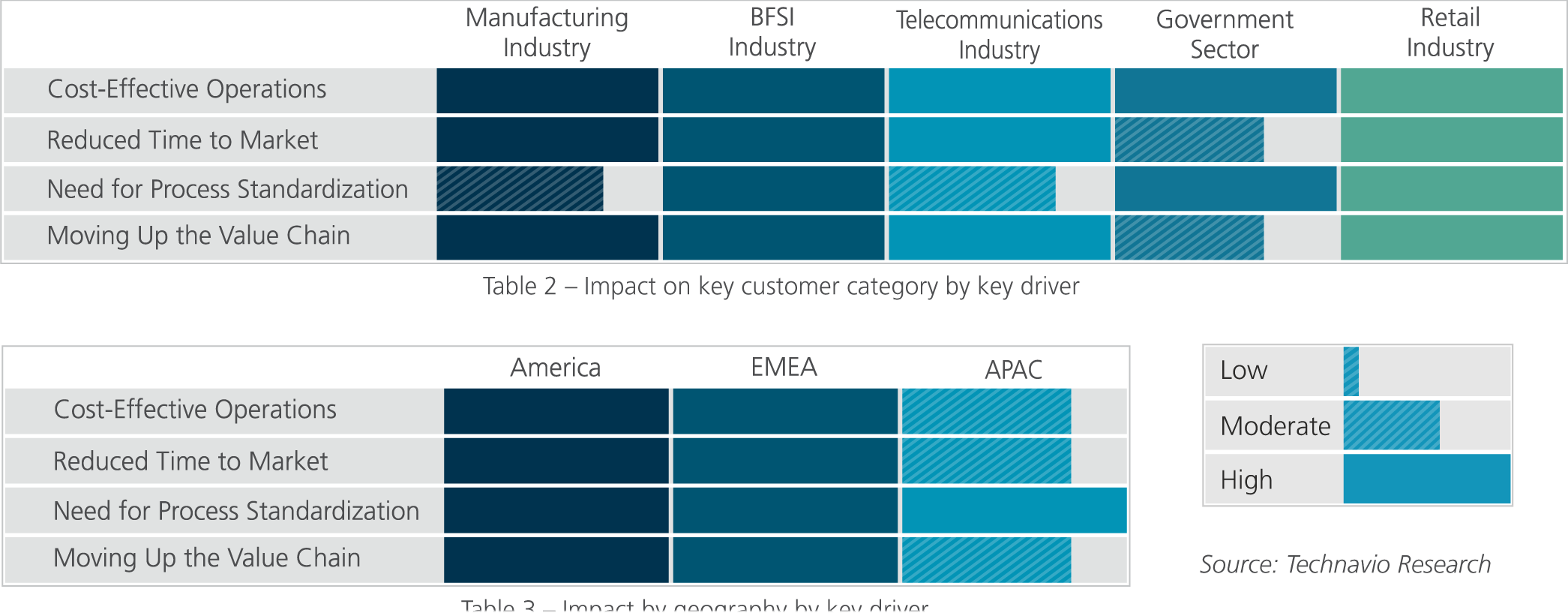
The Nearshoring Advantage
Traditionally, the popular destinations for procurement outsourcing have been low-cost countries, such as India and Philippines, which offer a skilled labor force at lower prices, excellent infrastructure and knowledge of these services. But high levels of inflation and a rise in labor costs have made these countries less cost effective. Also, enterprises are increasingly looking for value beyond costs savings from their procurement outsourcing engagements.
Over the last decade, Latin America has established itself as a preferred destination for process outsourcing. Although, not quite cost competitive when compared with India or Philippines, Latin America offers several advantages beyond cost arbitrage, especially for companies based in the U.S. and Canada, or even European companies looking to outsource or nearshore their procurement operations.
Brazil, Mexico, Costa Rica, Colombia and Argentina are some of the most popular outsourcing destinations in Latin America. Companies like P&G, Citibank, Modelez, Johnson & Johnson and Amway, among others, have opted to outsource at least one of their business processes to Latin America for its strategic advantages.
The advantage of Latin America is its cultural affinity, especially with the U.S., skilled workforce and proficiency in both, Spanish and English, with neutral accents facilitating communication. Also, a closer time zone makes it easier to coordinate activities between headquarters and shared services centers.
The Governments in these regions are focused on supporting and developing the service industry. One example is of Costa Rica. This Central American country, with skilled labor and excellent bilingual and technical capabilities, is home to several shared services centers and contact centers for U.S.-based companies. Costa Rica has invested heavily in education and has a rich talent pool of skill resources capable of speaking in many languages, such as English, Spanish, and Portuguese.
Mexico, another key player in the BPO sector, is considered to be among the best locations to set up a shared services center. Mexico currently has 30 technological clusters that specialize in IT and BPO, distributed across 20 different entities across the country.
Though each of these countries present specific challenges to overcome, all of them have an interesting alternative to offer in the market and compete globally.
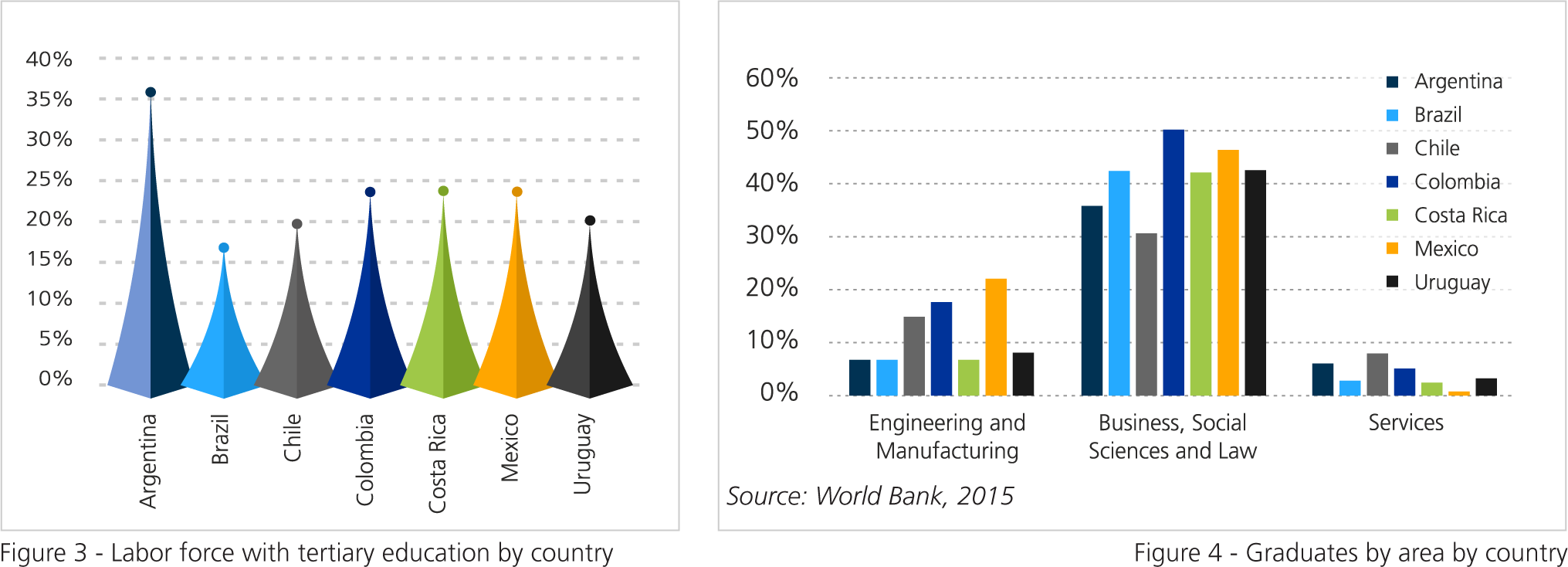
Top Locations for Procurement BPO Services in Latin America
Latin American giants, Brazil and Mexico, have the strongest BPO market in the region with special focus on national companies, especially in Brazil. Nevertheless, the rising economies in regions like Costa Rica and Colombia are encouraging companies to establish new Shared Services Centers in these regions. The following countries present interesting options for nearshoring operations:
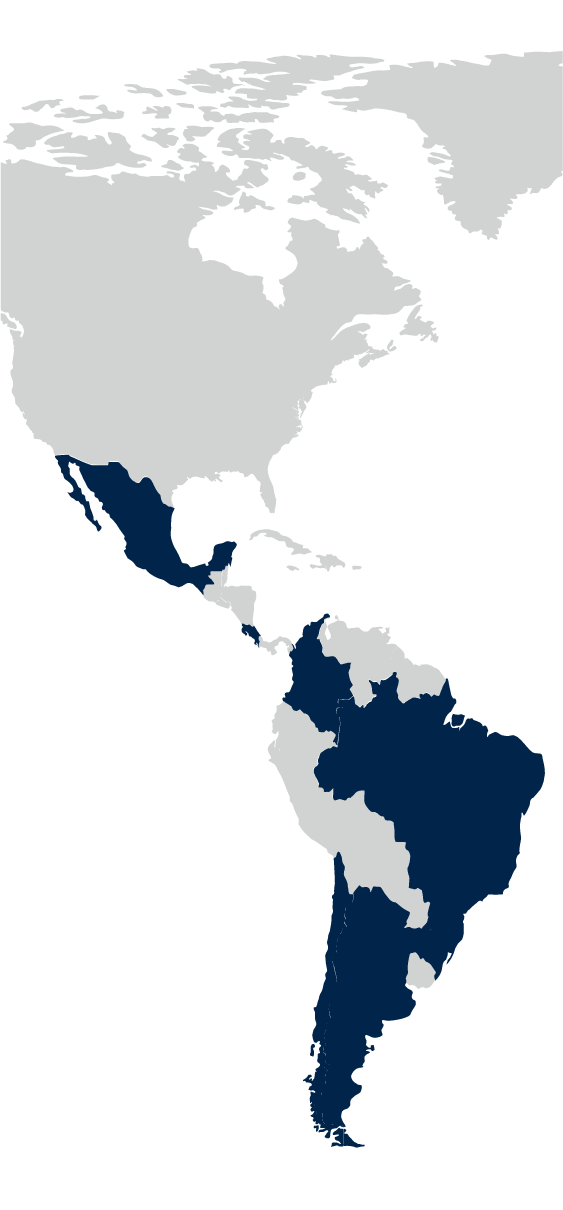
Mexico
- Closest to United States
- More developed market for BPO in the region, especially in FAO
- Key Cost (Salary, Real Estate) higher than most peers
Costa Rica
- Good bilingual skills
- Strong precence of large international (captive) service centers and vendors
- Limited work force availability given population size and potential saturation
Colombia
- Contact center primary focus - Spanish Speakers
- Drive 70 percent income from service to local firms
- In past few years the offers to international firms is growing fast
Brazil
- Significantly outnumbers country peers in call center and ITO industries
- It has strong domestic focus
Chile
- 5 percent of LATAM market share
- Remarkable political stability and business enviroment
- Limited availability of professionals fluent in English
Argentina
The political situation is a red flag in this South American country that has been struggling with crisis since the beginning of the 2000s. The government is currently more interested in solving the internal issues. Bureaucracy and limited skilled labor force reduce Argentina’s attractiveness, however, the country has a special cultural affinity not only with the U.S., but also with Europe, expanding the scope of companies interested in outsourcing services to this region. Bilingual capabilities and relatively low wages make Argentina an attractive alternative., especially if the political situation stabilizes.
Brazil
After enjoying long-term stability, the Petrobras scandal (a $2 billion corruption case at the country’s state-owned oil company that ensnared Petrobras officials, other companies,the former president and other highly placed politicians) has cast a large shadow over the current government. Also, social unrest has been a problem since the FIFA World Cup in 2014. From a technical point of view, Brazil has many skilled professionals who speak English and Spanish. In addition, there is a large pool of specialized professionals who contribute to strengthening Brazil’s image as a BPO destination. According to The Economist, however, Brazil’s economy is predicted to shrink by up to 3 percent in 2016, not much less than it did in 2015.
Chile
Political and social unrest is new to this country. It began after Chile was declared a first world economy a few years ago. Hence, the wages are pretty high as compared to the region average, but the availability of an English-speaking workforce is very low.
Mexico
Mexico is a big economy that uses its closeness to the U.S., low wages and skilled labor force, to attract business. Owing to its proximity to the U.S., Mexico presents the benefit of cultural affinity. However, Mexico’s current situation in terms of violence in certain areas, including hijacking and kidnapping by drug cartels, weakens its potential as an outsourcing destination.
Colombia
Although the traditional perception about Colombia is negative due to its history of drug cartels and violence, the outlook has improved in recent years. Colombia is one of the countries with lowest wages in the region and the Government is working hard to make it an interesting destination for BPO. Important points to consider are the lack of skilled workforce and the fact that there is a potential liability resulting from multinational companies leaving the country.
Costa Rica
A report by global outsourcing and investments advisory firm Tholons ranks Costa Rica as one of the best outsourcing destinations in the Latin American region with several shared service centers and call centers of leading multinationals, such as P&G, Intel and HP. The reatively less population in the country could be a problem, however, the work force is highly skilled and the government is willing to support these kind of activities, especially through CINDE — The Costa Rican Investment Promotion Agency.
Key Considerations When Outsourcing Procurement to Latin America
Enterprises must keep the following considerations in mind when outsourcing their procurement operations to a Latin American service provider:
- Domain Expertise Capability: This is the ability to share and implement professional knowledge to meet the client’s requirements. The supplier must be familiar with the functional domain and understand the client’s idiosyncrasies. Sometimes this familiarization starts at the employee level and is then transferred from client to supplier.
- Flexibility: This is the capability of a supplier to align its business procurement model with the customers’ needs and capacity. The supplier must be able to train its staff based on the clients’ demands in terms of spoken language, working hours for different time zones, material requirements planning (MRP) management and industry needs.
- Category Experience: Evaluate the category experience of each supplier to know their fields of expertise. Most of the big firms have a SME network across their companies to offer a better understanding of the category and specialized strategies. Every industry requires a completely different strategy to be implemented. Analyze the suppliers’ outcome in every category and compare it with the market.
- Process Improvement Capability: When the procurement department is to be outsourced, the supplier should be able to design and implement process improvements and receive solution proposals to move toward a continuous and lean process improvement.
- Governance Capability: Define the tracking method and KPIs to measure the performance of service over a period time. Establishing a bilateral governance agreement sets a clear start for the project. Define escalation procedures and share them with the multifunctional team; set clear and objective sanctions.
- Technology Tools: One way to improve the performance and achieve, or even exceed, client expectations is through technology implementation. Technology tools, year-by-year, play an important role in analysis optimization; tools like e-auction platforms facilitate and optimize operations and management methods of critical activities or events.
- Worldwide Presence with Local Resources: A supplier with a wide footprint around the globe is a guarantee of experience, however, it adds value when local resources are offered. It means that they are able to manage a more customized and complex service, which allows better project management. Global operation models enable the use of top analytical tools, innovative strategies and technology, etc. which is reflected on efficiency, scalability and flexibility.

